Deep planting tomatoes is one of the easiest and most effective ways of growing tomatoes. It may seem like a small thing but how deep in the ground you plant your tomatoes can actually have a huge impact on the plants’ root systems which allow your tomato plants to grow larger and produce much more fruit.
For this post, I planted a tomato using the deep plant method and I took pictures of every step of the process so you can see exactly how to do it and what each step should look like.
The only things you need to follow this guide are:
- A tomato plant
- A sunny spot in a garden or greenhouse
- A trowel, a spade, or another tool for digging
- Water
Let’s get started with the first step.
1. Find a Spot That Gets At Least 6-8 Hours of Sun
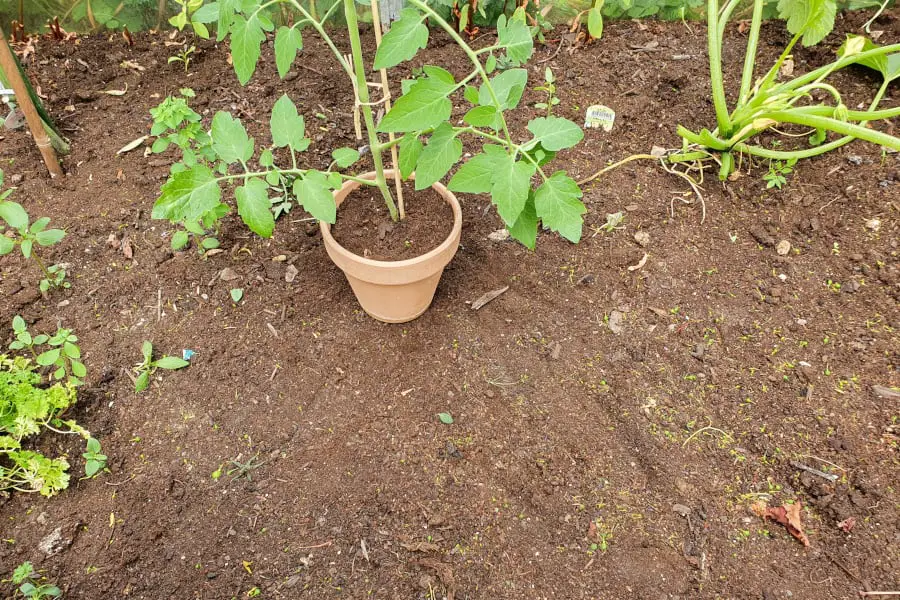
Finding a spot in your garden where your tomato plant can get plenty of direct sunlight will have a huge impact on your plant’s ability to grow and produce fruit.
Tomato plants love warm and sunny weather and thrive the best when they get full sun for at least 6-8 hours per day.
The first thing you have to do when you want to deep plant a tomato plant is to find a good spot for it in your garden or greenhouse where it can get at least 6-8 hours of sunlight per day.
The ideal spot depends on what type of tomato plant you are growing and generally speaking, there are 2 types.
- Determinate tomato plants will grow to a certain size and produce all their fruit over a short period of time.
- Indeterminate tomato plants keep growing and producing fruit for the entire growing season until the temperatures dip below the freezing point.
I usually only grow indeterminate tomato varieties since I like to be able to pick a few tomatoes every day rather than get a large harvest at the same time. This is because indeterminate tomato varieties keep producing even after you harvest the fruit. You can read more about that here.
Since indeterminate tomato plants will grow much larger than determinate plants, they need more space.
As a general rule, indeterminate tomato plants should be placed 3-4 feet (91-122 cm) apart since they can grow very large. Determinate tomato plants can be placed 2 feet (60 cm) apart. Planting too close can inhibit your tomatoes from reaching their full size and increase the risk of pests.
Another thing to be aware of when choosing a spot for your tomato plant is the weather.
To reduce the risk of your plant being damaged, it can be a good idea to find a spot in your garden where your plant will be shielded from too much wind. If you are growing in a greenhouse, the wind is not an issue but make sure your tomato plant has enough room to grow.
Tomatoes cannot withstand frost so it is important that you do not plant them outside before you are sure there is no risk of frost.
I like to start my tomato plants from seed indoors a few weeks before the last frost and then plant them outside as early as possible. This is especially good if you are growing an indeterminate variety since it gives the plants the longest possible growing season.
It can, of course, be difficult to predict exactly when there is no risk of frost but that is not a problem. I usually just try to estimate it and then grow my plants indoors in a warm spot by a window where they receive some light for a few weeks until I’m sure there is no risk of frost.
Your tomato plant will grow in the spot you have chosen for a while so make sure you like the spot and that the plant won’t get in the way of anything else. Remember, indeterminate varieties can get huge.
2. Dig a hole that is 1-1.5 feet (30-45 cm) deep
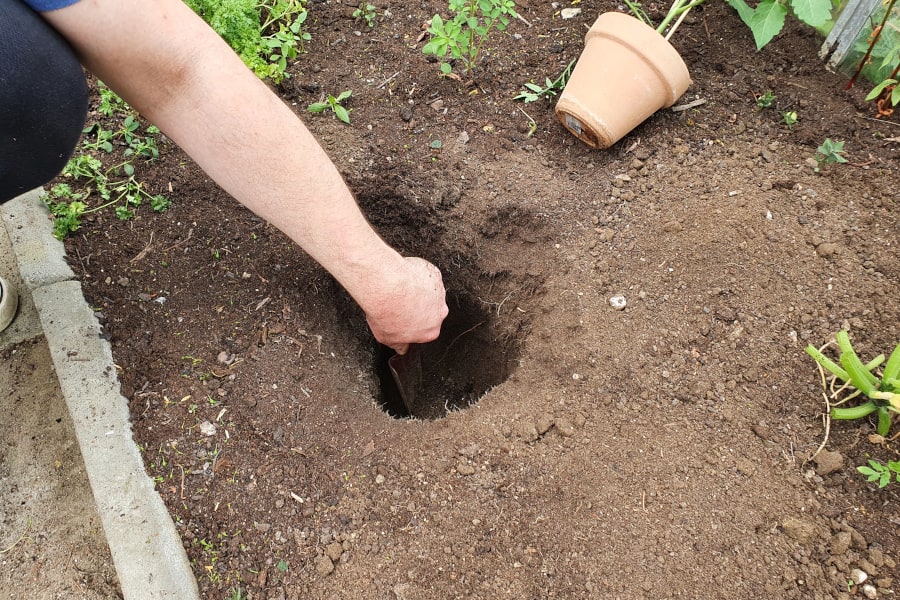
Now that you have found a good spot for your tomato plant, it is time to dig a hole.
Your task for this step is to dig a hole about 1-1.5 feet (30-45 cm) deep, depending on the size of your plant. The hole does not have to be very wide since you will only bury the main stem and not branches and leaves (but more on that in the next step)
Tomato plants are covered in tiny white hairs all over the main stem and if these hairs are underground, they all have the potential to turn into new roots. This is an incredible trick to know about since more roots mean larger and healthier plants as well as more, better-tasting fruit.
The purpose of deep planting tomatoes is to promote root growth and ensure a large, strong root system so the hole you dig for your tomato plant is actually an incredibly important part of the deep planting process.
As a general rule, between half and two-thirds of the tomato plant should be covered in soil when deep planting. A good rule of thumb is that about 1-1.5 feet (30-45 cm) of the plant should be covered. It is, however, important that at least 5-10 inches (12.5-25 cm) of the plant is above ground.
Tomato plants grow rapidly and will sometimes be larger and sometimes smaller but when you deep plant your tomato plant, just make sure that at least 5-10 inches (12.5-25 cm) of the plant, including a few green leaves, are above the ground and you will be just fine. If there are no green leaves above the ground, the plant cannot obtain energy from the sunlight and will die.
I usually use a small garden trowel or a spade for digging holes for my tomato plants. As you can see in the photo above, I used a small trowel this time but whatever works for you is fine.
I have written another post where I go more in-depth with this step. If you are interested, you can see it by following this link.
3. Cut Branches from the Bottom Half of the Plant

For this step, you have to remove any branches and leaves from your tomato plant from the part of the main stem that will be buried.
There are a few reasons why it is a good idea to remove any branches and leaves from the part of the main stem that is going to be underground.
First of all, removing the branches and leaves makes it much easier to put the plant in the hole. This is convenient but not the most important reason.
When planting a tomato plant, make sure to remove any branches and leaves from the part of the plant that will be underground. The primary reason why you should remove these branches and leaves is to reduce the risk of pests and diseases in your plant.
Other than removing the branches and leaves that would otherwise be buried, I also like to remove any branches and leaves that are hanging close to the ground.
Just make sure there are some branches and leaves left at the top of the plant!
I usually make sure no branches or leaves are hanging less than about 5 inches (12.5 cm) from the ground. I do this since my experience tells me that slugs can be ruthless and if one of the branches gets too close to the ground, you risk attracting slugs.
I have heard and read about some people who claim that removing branches like this is not necessary and while it might be true that it is not absolutely required, I have personally gotten significantly better results from doing so and it makes putting the plant in the ground easier, so why not.
4. Remove the Tomato Plant from the Container

Alright, it is almost time to actually plant the tomato plant but first, you have to carefully remove it from the container or pot without damaging the plant or the roots. This is how you do that.
If your plant is in a plastic pot or container, you can often remove it easily by pressing lightly all the way around the sides of the pot until it is loose enough so you can simply pull the plant out with its soil and roots. Make sure you do not damage the root system when removing the pot.
Many people use biodegradable pots made from peat for plants when they are young. I also often use peat pots but even though they are biodegradable, I still recommend removing them before putting your tomato plant in the ground.
Since peat pots are biodegradable, they can absolutely be put in the ground. My personal experience, however, tells me that they do not always decompose completely and if they do, it often takes a very long time. This can inhibit the growth of the plant’s root system and since the goal of deep planting is to grow a large, strong root system, there is absolutely no reason to inhibit it by not removing the peat pot.
If you use a biodegradable peat pot, you can remove it by peeling or breaking it off in pieces. Peat pots do not always decompose completely so the plant can become root bound which inhibits the plant’s ability to obtain water and nutrients from the soil as efficiently as otherwise.
After you remove your tomato plant from the pot, whether you use plastic, peat, or other pots, you should loosen the soil and the roots carefully so the roots hang loose. This will make it easier for them to spread once they are in the ground. Make sure not to remove all the soil from the plant and roots though.
5. Put Your Tomato Plant in the Hole
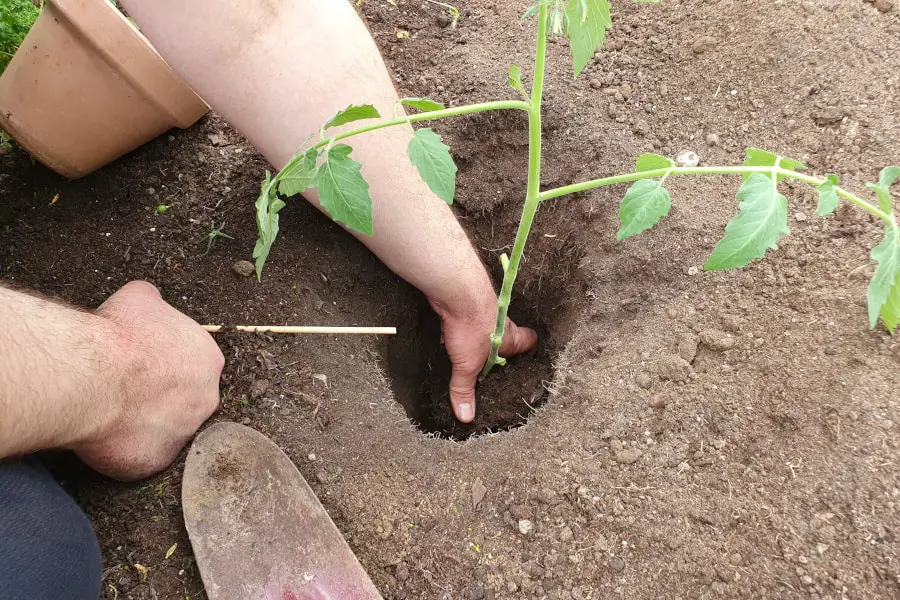
It is finally time to put your tomato plant in the ground.
Carefully put your tomato plant in the ground and make sure that no branches and leaves are covered in soil or hanging less than 5 inches (12.5 cm) from the ground to reduce the risk of pests and diseases. It is important that at least 5-10 inches of the plant is above ground to allow it to absorb enough sunlight.
Tomato plants will grow roots from all over the part of the main stem that is covered in soil and this is exactly why you are going to put a large part of it underground.
6. Fill the Hole with Soil Around the Plant
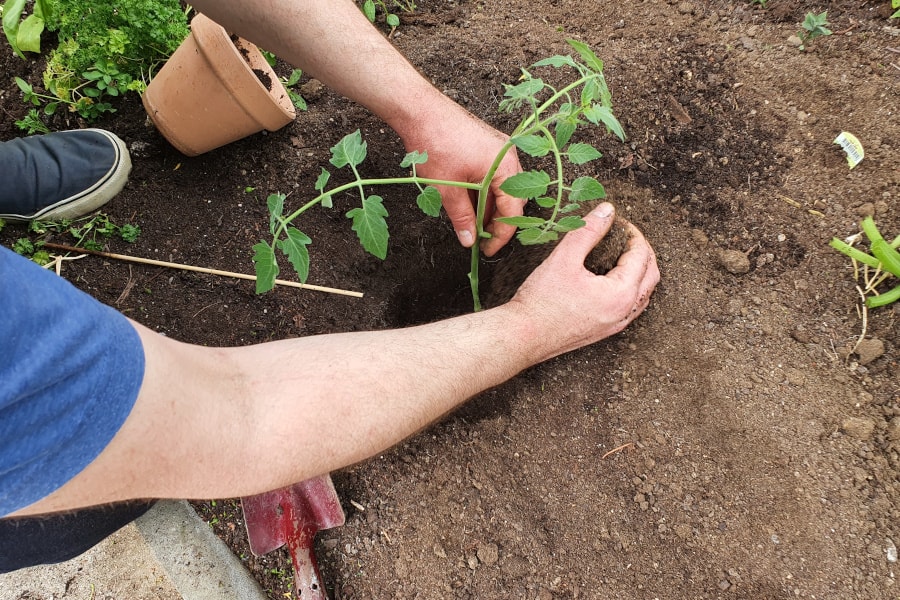
Now it is time to fill in the hole with soil.
When filling your hole with soil, make sure to fill it evenly all the way around the plant to prevent unnecessary pressure on any side of the plant. When the hole is full, you can cover the soil with a layer of mulch as that can help retain moisture and allow the plant to obtain water more efficiently.
Compost, straws, or grass clippings all make excellent mulches for tomato plants. If you have a lawn, you can save the freshly cut grass for a cheap and almost endless supply of mulch. If you use straws or compost, be sure there are no unexpected seeds in there to prevent unwanted plants to grow around your tomato plant.
7. Use a Stick or Cage to Support the Tomato Plant
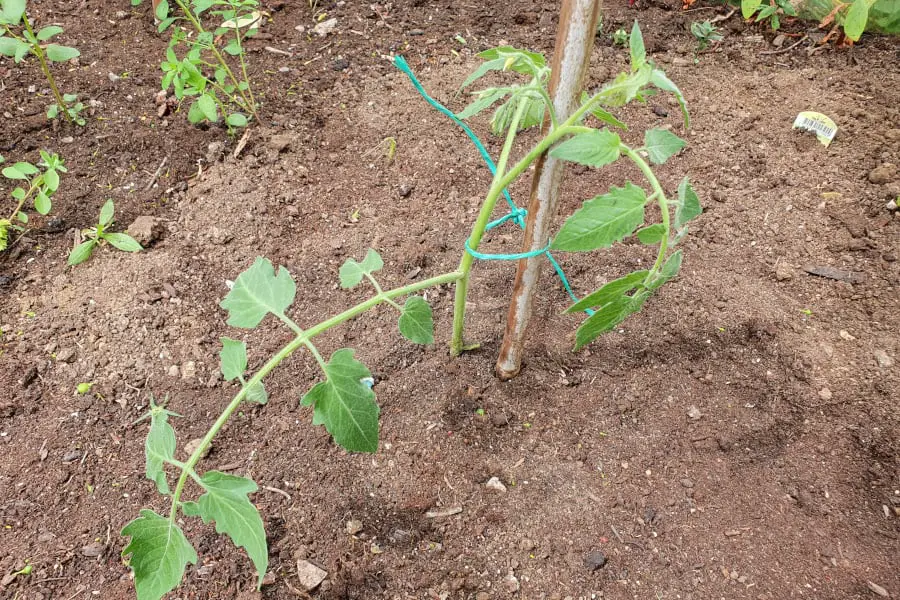
Well done! Once you are done setting up the support for your plant, you are actually completely done with deep planting your tomato, and after this step, all you have left to do is to water and prune your plant. I will get into that after this step.
Your result should look very similar to mine in the photo above.
It is important to build some support for your tomato plant since it can get huge if taken proper care of. Especially since you have now made sure it will grow a large, strong root system.
I have already briefly talked about the difference between determinate and indeterminate tomato varieties but just to refresh that, I will do it again here since it makes a big difference when it comes to supporting the plants.
- Determinate tomato varieties grow to a certain size and produce all their fruit over a relatively short period of time. Determinate varieties become much more dense and bushy than indeterminate varieties
- Indeterminate tomato varieties are vines that will keep growing and producing fruit for the entire growing season until frost comes.
Since determinate tomato plants generally only reach a height of 3-5 feet (about 90-150 cm), they do not always need support. One of the simplest ways of supporting them is by placing a bamboo stick next to the plant and tying a soft piece of thread or cloth around the plant and the stick.
It is especially important to support indeterminate tomato plants since they can get extremely large and the weight of the fruit can break the stem of the plant if it is not supported.
If you do not build any support for an indeterminate tomato plant, the fruit will be too heavy for the plant and hang close to the ground or lay directly on the ground which increases the risk of disease and pests such as slugs.
One of the most popular ways of supporting indeterminate tomato plants is with a tomato cage. Another common method is by placing a long bamboo stick next to the plant and then continuously tie the top of the plant to the stick near the top as it grows. Always use soft thread or cloth to prevent damage to the plant.
As you can see in the photo above, I personally just use long bamboo sticks for supporting my plants when I grow indeterminate tomatoes.
8. Water Your Tomato Plant Every Morning
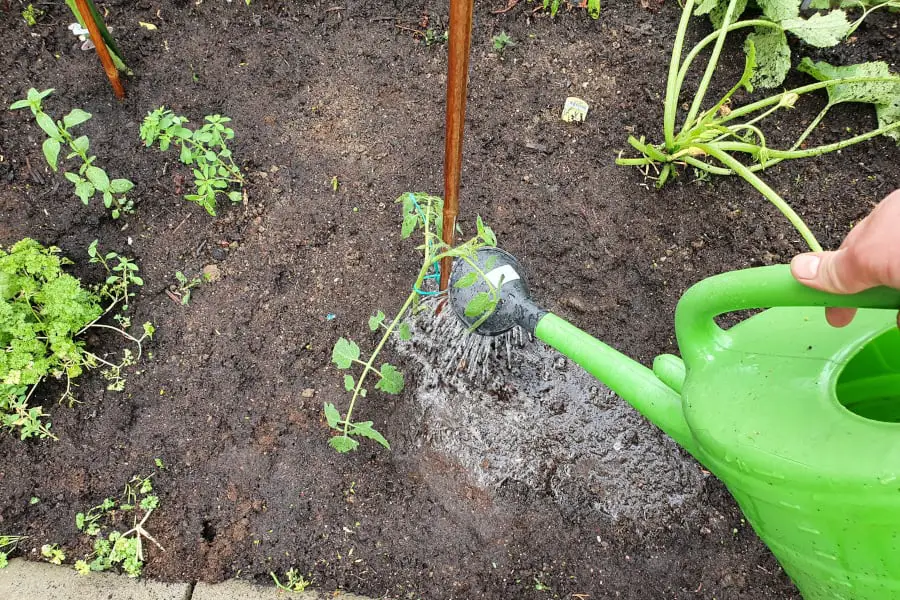
Tomato plants are very thirsty and require frequent watering.
You should water your tomato plant when the top 1-2 inches (2.5-5 cm) of the topsoil feels dry. The best time to water tomatoes is in the morning before the sun is too bright since warm, sunny weather can dry out the soil before the plant can absorb the water.
When possible, I like to keep an eye on my tomato plants and check up on them a few times throughout the day. On the warmest, most sunny days, it can often be necessary to water your tomato plant more than once.
You should also be careful not to overwater your tomatoes. I have some tips for that here.
While it is best to water tomatoes in the morning before the sun comes up, it can also be fine to water them in full sun, but if you do that, there are some things you should know as it can affect the plants’ health. I cover what you need to know in this post.
9. Prune Your Plant Throughout the Whole Season
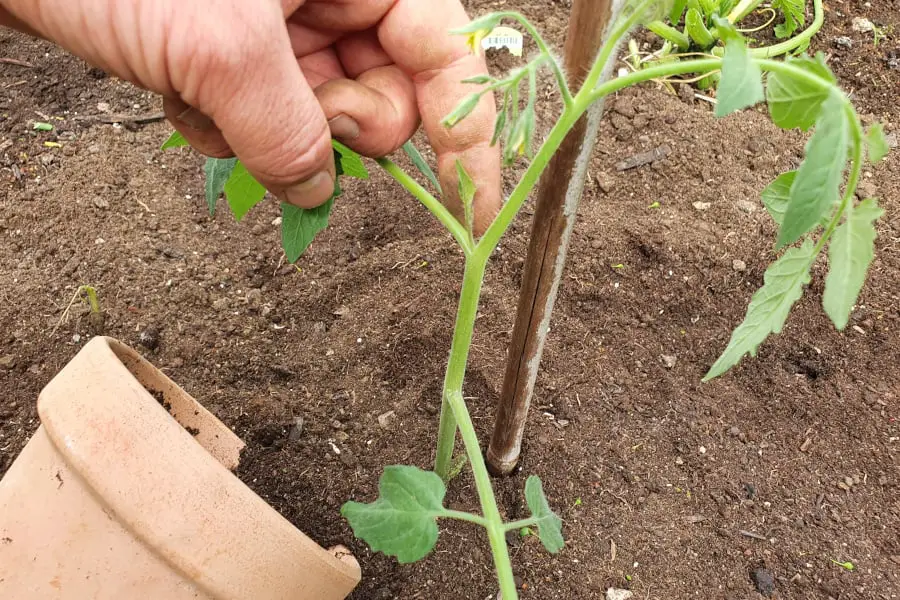
You should of course keep watering your plant throughout the entire growing season to keep it healthy. This will allow it to grow very large and produce lots of tasty, nutritious tomatoes for you to pick throughout the entire season.
Another important thing to do when growing tomatoes is to prune them often and remove any unwanted growth as early as possible to allow the plant to focus its energy on growing the main stem and its fruit.
What I mean when I say “unwanted growth” in this case is suckers. Suckers are the little shoots that grow between the main stem and the branches of the tomato plant. If you let suckers grow, they will turn into a new main stem and make your plant much more difficult to manage.
You can see a small sucker in the photo above. It is the small shoot between the stem and the large branch, right in front of my finger.
When the suckers are as small as in the photo above, you can just pinch them off with two fingers but if they are larger, you should use a pair of pruning shears to avoid damaging the plant.
Pruning your tomato plant right can make a huge difference for your plant and ultimately your harvest.
Pruning tomatoes is important, not only to prevent them from spending unnecessary energy on unwanted growth but also to improve the airflow. This reduces the risk of disease significantly. Prune your plant throughout the entire growing season.
I highly encourage you to take a look at this short video where the two hosts explain the process and importance of pruning tomatoes perfectly while showing you exactly how to do it.

